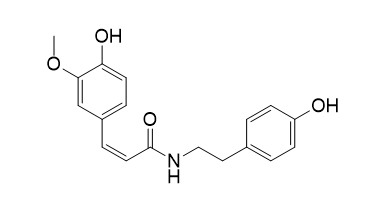Cis-N-Feruloyltyramine
Cis-N-Feruloyltyramine shows cytotoxicity against the P-388 cancer cell line. N-cis-Feruloyltyramine and N-trans-Feruloyltyramine are the inhibitors of in vitro prostaglandin (PG) synthesis.
Inquire / Order:
manager@chemfaces.com
Technical Inquiries:
service@chemfaces.com
Tel:
+86-27-84237783
Fax:
+86-27-84254680
Address:
1 Building, No. 83, CheCheng Rd., Wuhan Economic and Technological Development Zone, Wuhan, Hubei 430056, PRC
Providing storage is as stated on the product vial and the vial is kept tightly sealed, the product can be stored for up to
24 months(2-8C).
Wherever possible, you should prepare and use solutions on the same day. However, if you need to make up stock solutions in advance, we recommend that you store the solution as aliquots in tightly sealed vials at -20C. Generally, these will be useable for up to two weeks. Before use, and prior to opening the vial we recommend that you allow your product to equilibrate to room temperature for at least 1 hour.
Need more advice on solubility, usage and handling? Please email to: service@chemfaces.com
The packaging of the product may have turned upside down during transportation, resulting in the natural compounds adhering to the neck or cap of the vial. take the vial out of its packaging and gently shake to let the compounds fall to the bottom of the vial. for liquid products, centrifuge at 200-500 RPM to gather the liquid at the bottom of the vial. try to avoid loss or contamination during handling.
Histol Histopathol.2022, 18518.
Recent Pat Anticancer Drug Discov.2022, 17(4):416-426.
Front Pharmacol.2021, 12:764297.
Journal of Apiculture2019, 34(2):131-136
Nutr Res Pract.2023, 17(4):670-681.
Research Square2024, rs-4398438
J Cancer.2019, 10(23):5843-5851
Anticancer Res.2018, 38(4):2127-2135
The Korea Society of Pha.2014, 300-314
Antioxidants.2022, 11(4), 67.
Related and Featured Products
Food Chem. 2016 Oct 1;208:61-7
Antioxidants and α-glucosidase inhibitors from Ipomoea batatas leaves identified by bioassay-guided approach and structure-activity relationships.[Pubmed:
27132824]
Sweet potato (Ipomoea batatas) leaf (SPL) is an underused commercial vegetable with considerable bio-activities.
METHODS AND RESULTS:
By means of DPPH scavenging ability and α-glucosidase inhibitory oriented isolation, 9 and 7 compounds were isolated and identified, respectively. Among them, trans-N-(p-coumaroyl)tyramine (1), trans-N-feruloyltyramine (2), Cis-N-Feruloyltyramine (3), 4,5-feruloylcourmaoylquinic acid (8), caffeic acid ethyl ester (10), 7-hydroxy-5-methoxycoumarin (11), 7,3'-dimethylquercetin (13) and indole-3-carboxaldehyde (15), were firstly identified from SPL, and four of them (1, 2, 3 and 10) were firstly identified from genus Ipomoea. Phenethyl cinnamides and 3,4,5-triCQA exhibited the strongest α-glucosidase inhibition, while 3,4,5-triCQA and diCQAs were the dominant antioxidants.
CONCLUSIONS:
Structure-activity relationship revealed that higher caffeoylation of quinic acid and lower methoxylation of flavonols resulted in stronger antioxidant activity, and methylation and cis-configuration structure of phenethyl cinnamides weaken the α-glucosidase inhibition. Aforementioned results could help to explain the antioxidant activity and anti-diabetic activity of SPL, and provide theoretical basis for its further application.
Planta Med. 2003 Jul;69(7):667-72.
A cytotoxic butenolide, two new dolabellane diterpenoids, a chroman and a benzoquinol derivative formosan Casearia membranacea.[Pubmed:
12898426]
METHODS AND RESULTS:
Investigation of a cytotoxic chloroform-soluble fraction of the stem of Casearia membranacea (Flacourtiaceae) led to the isolation of five new compounds, including one butenolide, casealactone (1), one chroman, caseamemin (2), two dolabellane diterpenoids, casearimene A (3) and casearimene B (4), one benzoquinol ether, casearinone (5), together with fifteen known compounds, including two amides, N- trans-feruloyltyramine (6) and Cis-N-Feruloyltyramine (7), six steroids, beta-sitosterol (8), stigmast-5-ene-3beta,7alpha-diol (9), stigmast-5-ene-3beta,7beta-diol (10), stigmastane-3beta,5alpha,6beta-triol (11), beta-sitostenone (12), beta-sitosterol 3- O-beta-glucoside (13), two triterpenoids, squalene (14) and friedelin (15), one lignan, (+/-)-syringaresinol (16), two benzenoids, syringaldehyde (17) and vanillic acid (18), one ester, methyl hexadecanoate (19), and anthraquinone (20), respectively.
CONCLUSIONS:
Among these isolates, 1 showed cytotoxicity against P-388 and HT-29 cancer cell lines in vitro, and 6 and 7 showed cytotoxicity against the P-388 cancer cell line. The structures of these compounds were determined by means of spectroscopic techniques, and the structure of 3 was confirmed by X-ray crystallographic analysis.
Chem Pharm Bull (Tokyo). 1992 Feb;40(2):396-400.
Inhibition of in vitro prostaglandin and leukotriene biosyntheses by cinnamoyl-beta-phenethylamine and N-acyldopamine derivatives.[Pubmed:
1606635]
METHODS AND RESULTS:
Tran-N-Feruloyltyramine and Cis-N-Feruloyltyramine were isolated as the inhibitors of in vitro prostaglandin (PG) synthesis from an Indonesian medicinal plant, Ipomoea aquatica (Convolvulaceae). In order to clarify structure activity relationships, cinnamoyl-beta-phenethylamines with possible combinations of naturally occurring cinnamic acids and beta-phenethylamines were synthesized and tested for their inhibitory activities against PG synthetase and arachidonate 5-lipoxygenase.
CONCLUSIONS:
The compounds containing catechol groups such as N-caffeoyl-beta-phenethylamine (CaP) showed higher inhibitory effects on PG synthetase.
J Nat Prod. 2003 Aug;66(8):1089-93.
Isolation and characterization of miscellaneous secondary metabolites of Deprea subtriflora.[Pubmed:
12932130]
METHODS AND RESULTS:
Two new C-18 norwithanolides based on a C(27) skeleton, subtrifloralactones K (1) and L (2), a new C-18 oxygenated withanolide, 13 beta-hydroxymethylsubtrifloralactone E (3), and a new alpha-ionone derivative, (+)-7 alpha,8 alpha-epoxyblumenol B (4), along with five known compounds, philadelphicalactone A (5), (2S,3S,4R)-2-[(2R)-2'-hydroxytetracosanoylamino]-1,3,4-octadecanetriol (6), trans-N-feruloyltyramine, Cis-N-Feruloyltyramine, and (S)-coriolic acid, were isolated from additional active fractions of the chloroform-soluble extract of Deprea subtriflora, using a quinone reductase (QR) induction assay as a monitor.
CONCLUSIONS:
The structures of compounds 1-4 were characterized by spectroscopic data interpretation.
The potential cancer chemopreventive activities of all isolates in terms of their ability to induce QR activity with cultured Hepa 1c1c7 mouse hepatoma cells were evaluated.



